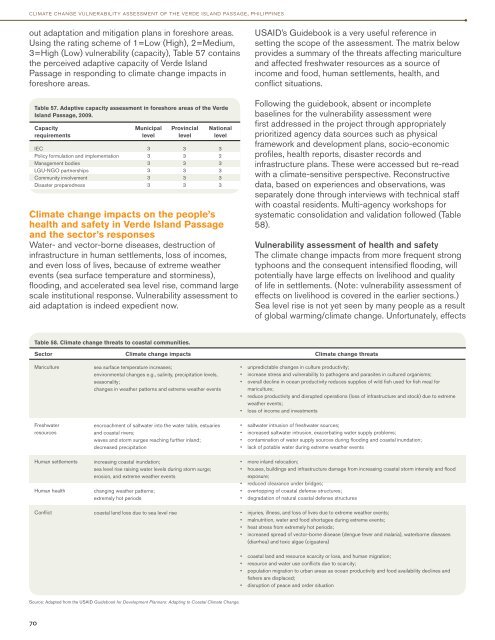of the Verde Island Passage, Philippines - weADAPT
of the Verde Island Passage, Philippines - weADAPT
of the Verde Island Passage, Philippines - weADAPT
You also want an ePaper? Increase the reach of your titles
YUMPU automatically turns print PDFs into web optimized ePapers that Google loves.
climate change vulnerability assessment <strong>of</strong> <strong>the</strong> verde island passage, philippines<br />
out adaptation and mitigation plans in foreshore areas.<br />
Using <strong>the</strong> rating scheme <strong>of</strong> 1=Low (High), 2=Medium,<br />
3=High (Low) vulnerability (capacity), Table 57 contains<br />
<strong>the</strong> perceived adaptive capacity <strong>of</strong> <strong>Verde</strong> <strong>Island</strong><br />
<strong>Passage</strong> in responding to climate change impacts in<br />
foreshore areas.<br />
Table 57. Adaptive capacity assessment in foreshore areas <strong>of</strong> <strong>the</strong> <strong>Verde</strong><br />
<strong>Island</strong> <strong>Passage</strong>, 2009.<br />
Capacity Municipal Provincial National<br />
requirements level level level<br />
IEC<br />
Policy formulation and implementation<br />
Management bodies<br />
LGU-NGO partnerships<br />
Community involvement<br />
Disaster preparedness<br />
Climate change impacts on <strong>the</strong> people’s<br />
health and safety in <strong>Verde</strong> <strong>Island</strong> <strong>Passage</strong><br />
and <strong>the</strong> sector’s responses<br />
Water- and vector-borne diseases, destruction <strong>of</strong><br />
infrastructure in human settlements, loss <strong>of</strong> incomes,<br />
and even loss <strong>of</strong> lives, because <strong>of</strong> extreme wea<strong>the</strong>r<br />
events (sea surface temperature and storminess),<br />
flooding, and accelerated sea level rise, command large<br />
scale institutional response. Vulnerability assessment to<br />
aid adaptation is indeed expedient now.<br />
3<br />
3<br />
3<br />
3<br />
3<br />
3<br />
3<br />
3<br />
3<br />
3<br />
3<br />
3<br />
3<br />
2<br />
3<br />
3<br />
3<br />
3<br />
USAID’s Guidebook is a very useful reference in<br />
setting <strong>the</strong> scope <strong>of</strong> <strong>the</strong> assessment. The matrix below<br />
provides a summary <strong>of</strong> <strong>the</strong> threats affecting mariculture<br />
and affected freshwater resources as a source <strong>of</strong><br />
income and food, human settlements, health, and<br />
conflict situations.<br />
Following <strong>the</strong> guidebook, absent or incomplete<br />
baselines for <strong>the</strong> vulnerability assessment were<br />
first addressed in <strong>the</strong> project through appropriately<br />
prioritized agency data sources such as physical<br />
framework and development plans, socio-economic<br />
pr<strong>of</strong>iles, health reports, disaster records and<br />
infrastructure plans. These were accessed but re-read<br />
with a climate-sensitive perspective. Reconstructive<br />
data, based on experiences and observations, was<br />
separately done through interviews with technical staff<br />
with coastal residents. Multi-agency workshops for<br />
systematic consolidation and validation followed (Table<br />
58).<br />
Vulnerability assessment <strong>of</strong> health and safety<br />
The climate change impacts from more frequent strong<br />
typhoons and <strong>the</strong> consequent intensified flooding, will<br />
potentially have large effects on livelihood and quality<br />
<strong>of</strong> life in settlements. (Note: vulnerability assessment <strong>of</strong><br />
effects on livelihood is covered in <strong>the</strong> earlier sections.)<br />
Sea level rise is not yet seen by many people as a result<br />
<strong>of</strong> global warming/climate change. Unfortunately, effects<br />
Table 58. Climate change threats to coastal communities.<br />
Sector Climate change impacts Climate change threats<br />
Mariculture<br />
Freshwater<br />
resources<br />
Human settlements<br />
Human health<br />
Conflict<br />
sea surface temperature increases;<br />
environmental changes e.g., salinity, precipitation levels,<br />
seasonality;<br />
changes in wea<strong>the</strong>r patterns and extreme wea<strong>the</strong>r events<br />
encroachment <strong>of</strong> saltwater into <strong>the</strong> water table, estuaries<br />
and coastal rivers;<br />
waves and storm surges reaching fur<strong>the</strong>r inland;<br />
decreased precipitation<br />
increasing coastal inundation;<br />
sea level rise raising water levels during storm surge;<br />
erosion, and extreme wea<strong>the</strong>r events<br />
changing wea<strong>the</strong>r patterns;<br />
extremely hot periods<br />
coastal land loss due to sea level rise<br />
• unpredictable changes in culture productivity;<br />
• increase stress and vulnerability to pathogens and parasites in cultured organisms;<br />
• overall decline in ocean productivity reduces supplies <strong>of</strong> wild fish used for fish meal for<br />
mariculture;<br />
• reduce productivity and disrupted operations (loss <strong>of</strong> infrastructure and stock) due to extreme<br />
wea<strong>the</strong>r events;<br />
• loss <strong>of</strong> income and investments<br />
• saltwater intrusion <strong>of</strong> freshwater sources;<br />
• increased saltwater intrusion, exacerbating water supply problems;<br />
• contamination <strong>of</strong> water supply sources during flooding and coastal inundation;<br />
• lack <strong>of</strong> potable water during extreme wea<strong>the</strong>r events<br />
• more inland relocation;<br />
• houses, buildings and infrastructure damage from increasing coastal storm intensity and flood<br />
exposure;<br />
• reduced clearance under bridges;<br />
• overtopping <strong>of</strong> coastal defense structures;<br />
• degradation <strong>of</strong> natural coastal defense structures<br />
• injuries, illness, and loss <strong>of</strong> lives due to extreme wea<strong>the</strong>r events;<br />
• malnutrition, water and food shortages during extreme events;<br />
• heat stress from extremely hot periods;<br />
• increased spread <strong>of</strong> vector-borne disease (dengue fever and malaria), waterborne diseases<br />
(diarrhea) and toxic algae (ciguatera)<br />
• coastal land and resource scarcity or loss, and human migration;<br />
• resource and water use conflicts due to scarcity;<br />
• population migration to urban areas as ocean productivity and food availability declines and<br />
fishers are displaced;<br />
• disruption <strong>of</strong> peace and order situation<br />
Source: Adapted from <strong>the</strong> USAID Guidebook for Development Planners: Adapting to Coastal Climate Change.<br />
70
















